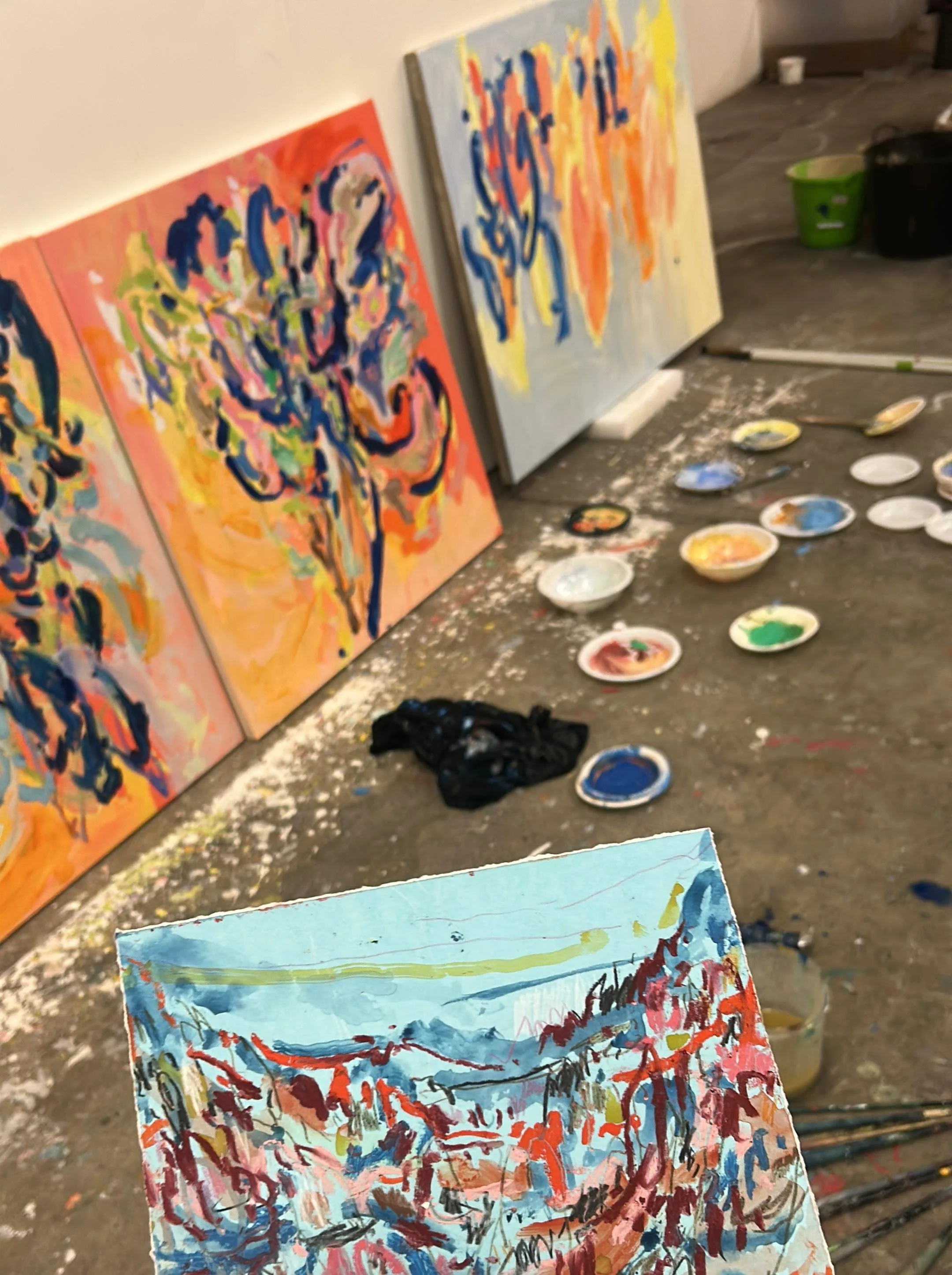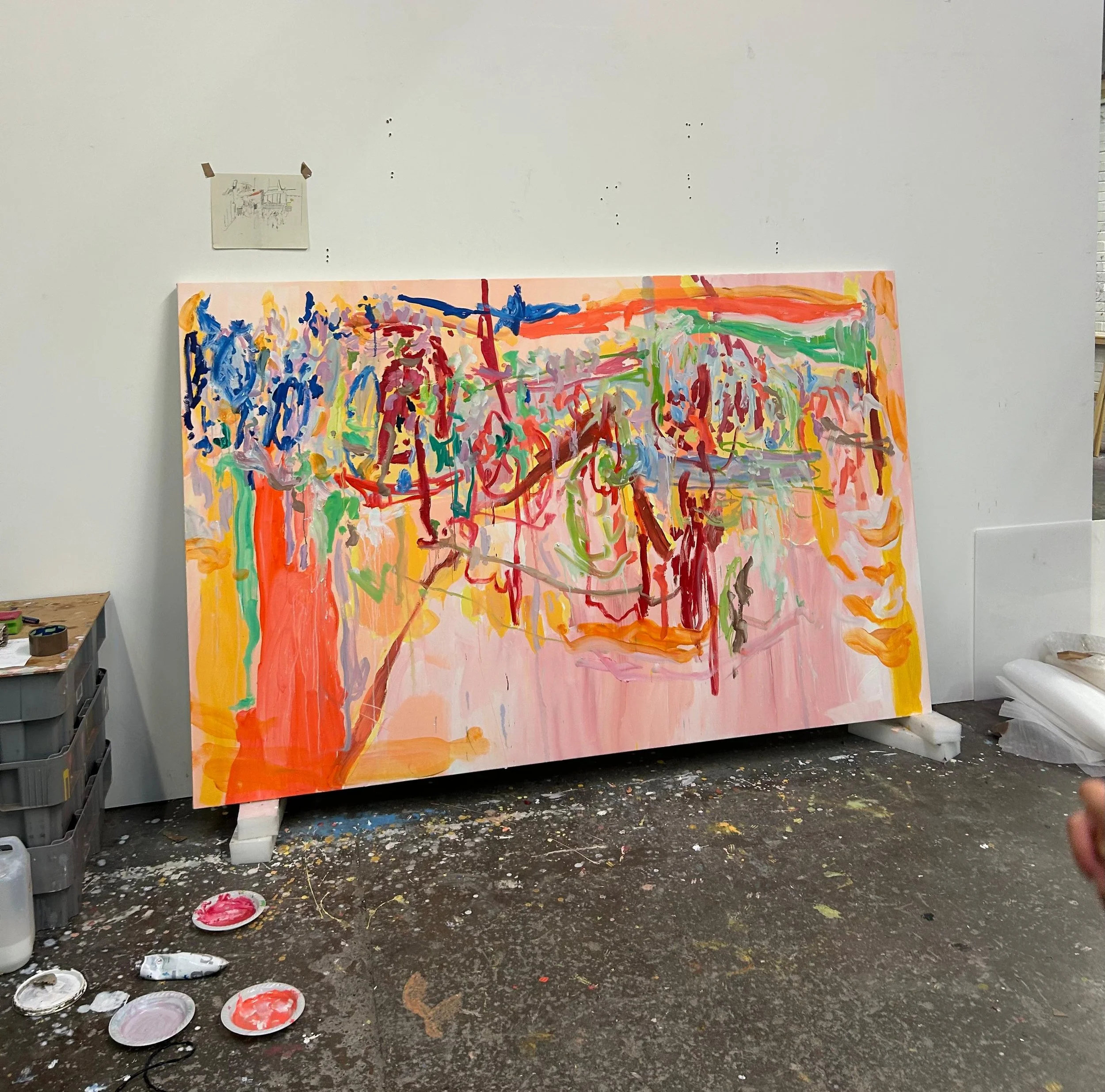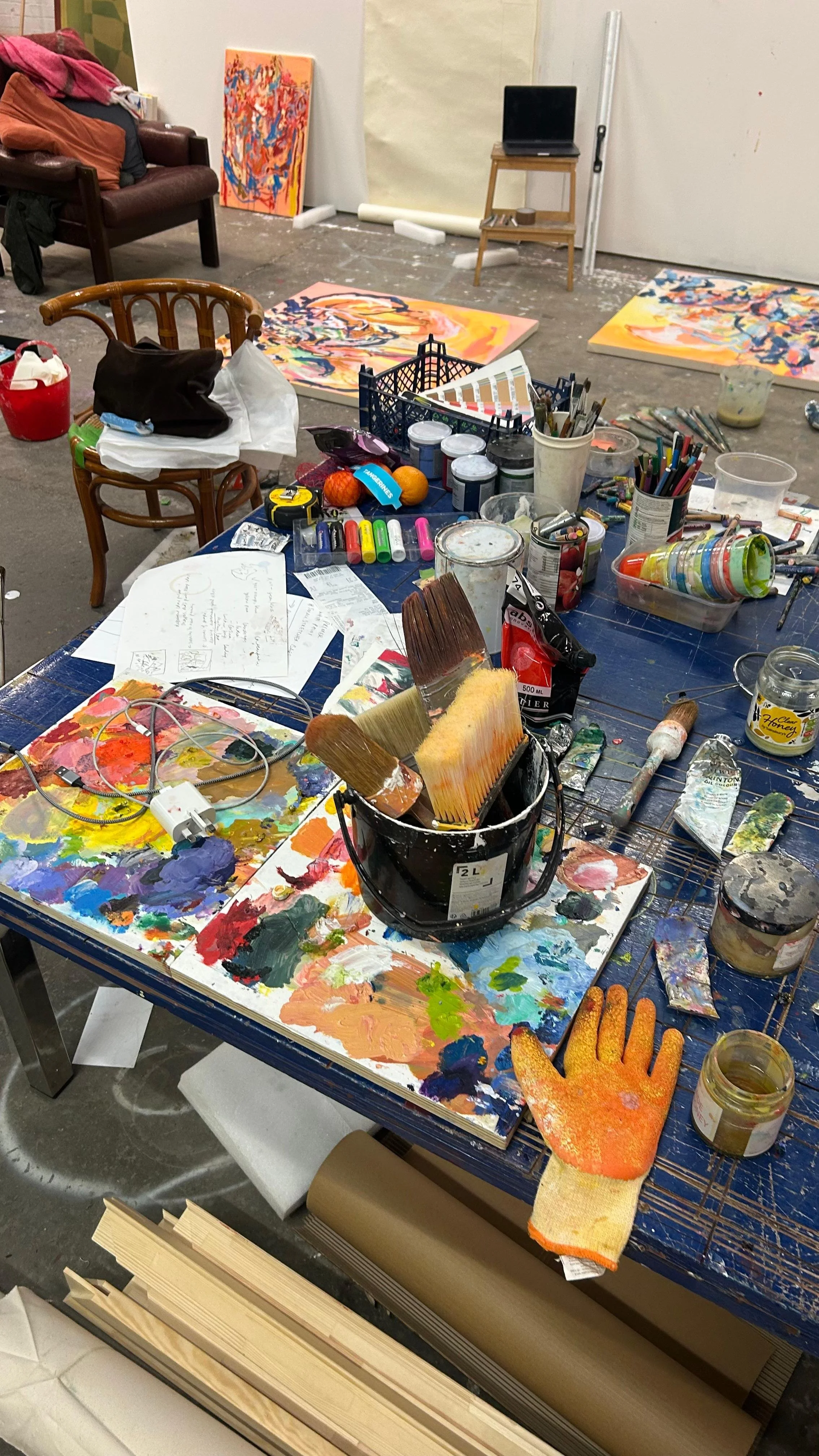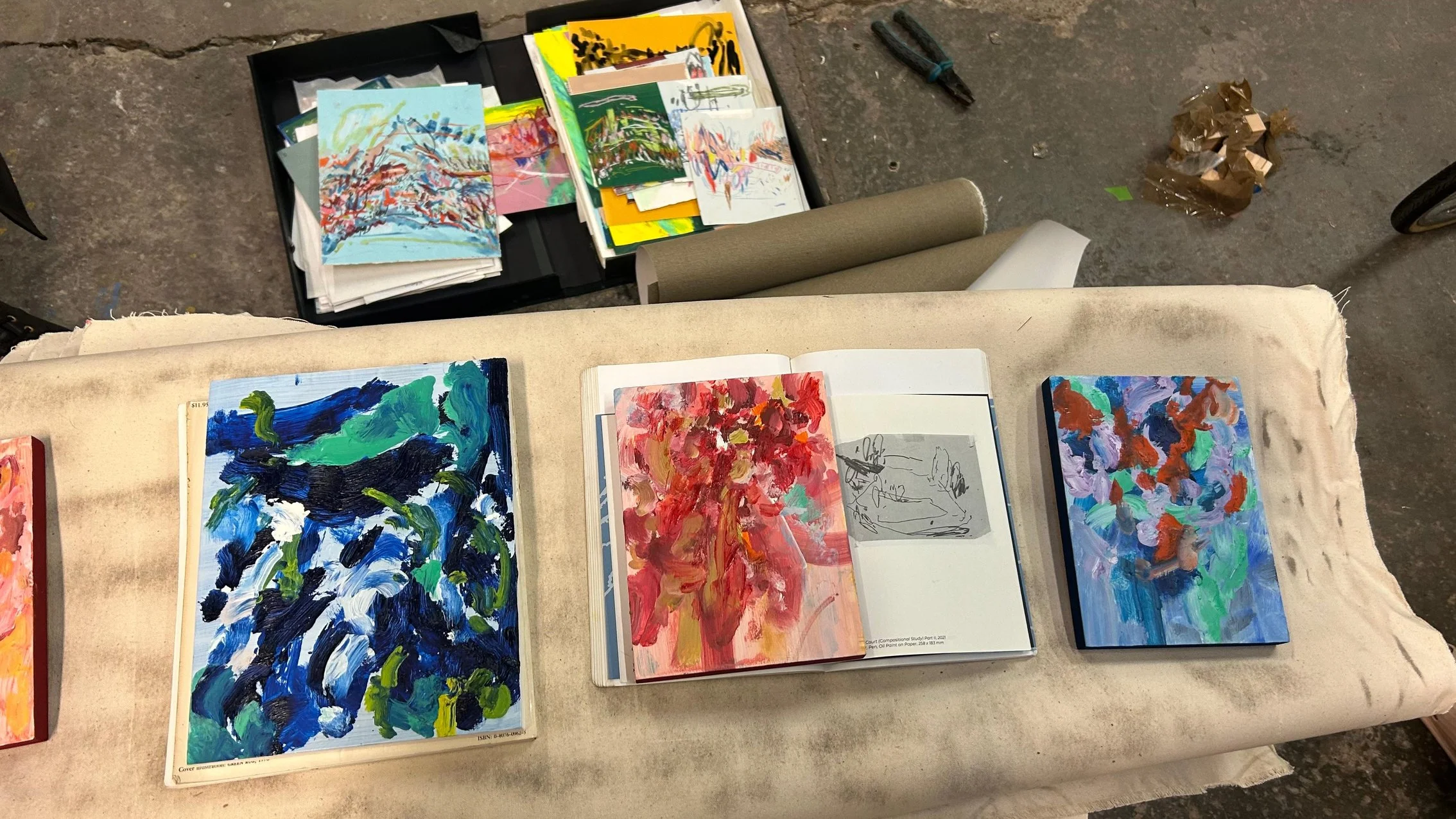Studio Visit: Inside the Vibrant World of Lydia Hamblet
Stepping into Lydia Hamblet’s studio feels like walking into sunlight. Her canvases glow with layered brushstrokes and radiant tones — landscapes that hum with memory, movement, and emotion. Each painting captures not just what she sees, but how she feels: present, warm, alive.
“Joy is the biggest act of resistance,” says Hamblet. “That’s what I want my paintings to express — warmth, healing, and togetherness.”
This philosophy infuses her work with a rare sincerity — one that will soon be showcased in her upcoming exhibition with Bulgari in London, The Art of Colours, opening Friday, October 10, in conjunction with Frieze London 2025.
Lydia Hamblet studio shot of "Looking Out The Same Window” Oil, Oil Bar and Acrylic on Canvas
The Language of Colour and Emotion
Hamblet’s latest works radiate optimism. The artist’s colour palette — golden yellows, coral pinks, deep greens — evokes the warmth of late summer.
“I want the paintings to feel cozy, to carry a healing energy,” she explains. “Recently, I heard someone at a gig say, ‘Joy is the biggest act of resistance.’ That idea really stayed with me — it’s what I’m trying to channel.”
Her current series began from a rediscovered sketch.
“I couldn’t remember where it came from — maybe Morocco,” she laughs. “As I painted, the act of making helped me recall the space, but then it took on a life of its own.”
Sketch from Morocco inspiration for Bvlgari “Art Of Colours” Show 2025
From Printmaking to Painting — How Lydia Hamblet transitioned
Though she’s always been creative, Hamblet’s full embrace of painting came after completing her Master’s in Printmaking.
“A lot of my print work involved painting directly onto the screen,” Lydia Hamblet recalls. “So moving into painting felt natural. I love how much freedom it gives me — I’m still learning with every piece.”
This layered, textural foundation from her printmaking days continues to inform her paintings, where transparency, rhythm, and mark-making intertwine.
Studio shot Lydia Hamblet
Movement, Memory, and Shared Spaces
Lydia Hamblet’s canvases often suggest motion — flowing brushstrokes that hint at figures, nature, or landscapes in flux.
“Some works are loosely based on sports imagery,” she says, “but there’s always nature intertwined — plants, energy, light. It’s about capturing the feeling of a space, creating a shared experience through memory.”
Her practice is grounded in emotional resonance rather than literal representation. Each painting becomes a kind of living memory.
Painting from Memory
“Sometimes I start from a loose sketch, but more often I paint from memory,” Hamblet explains. “It’s like re-creating familiar compositions in new ways — reworking colours, gestures, emotions. I’ll map the piece in my head and let it unfold naturally.”
Working on multiple canvases at once, she allows colours and ideas to move between works.
“I might mix a colour for one painting and find it works beautifully on another. Over time, they all start to influence each other — it’s like a conversation between them.”
Lydia Hamblet’s artworks
Edges, Layers, and the Honesty of Process
One signature of Lydia Hamblet’s work is her raw approach: unframed canvases, visible edges, and traces of the making process.
“I love leaving the edges raw,” she says. “The drips, the fingerprints — they’re part of the story. When I look at other artists’ work, I always check the edges; it shows how the painting came to life.”
In exhibitions, she prefers the canvases unframed.
“It feels more honest. I don’t mind if collectors frame them later, but in the gallery, I want people to see the evidence of making.”
Material, Texture, and Technique
Lydia Hamblet often combines acrylic and oil paint to create depth and contrast.
“I started using more acrylic after painting a large mural in Canary Wharf — I had all this leftover paint,” she says, smiling. “Acrylic dries quickly, so it lets me build layers faster before adding oil. It’s changed the way I paint.”
Though her palette is currently warm and luminous, she remains open to change.
“Maybe I’ll explore deeper blues and cooler tones soon,” she muses. “But for now, I’m still drawn to the light.”
When Is a Painting Finished?
“That’s always the question,” Lydia laughs. “Sometimes I think a painting’s finished, but I come back the next day and see something new. You just have to trust your gut. I’d rather leave it slightly undone than overwork it.”
Her works evolve slowly, gathering layers over time.
“I love when a painting becomes part of the studio — when it lives with me for a while, collecting fragments of other works. It’s like a visual memory forming in real time.”
Collectors, Connection, and Continuity
As her career grows, Hamblet’s collector base has expanded internationally.
“I like knowing who collects the work — it’s part of who I was when I made it,” she says. “Sometimes I meet them through galleries, sometimes personally. I try to keep those relationships going when I can.”
“Deep Blue”, “Blush” and “Violet Hour” by Lydia Hamblet
The Art Of Colours at Bvlgari in London during Frieze 2025 presents new works by Lydia Hamblet
At the heart of Lydia Hamblet’s work is an insistence on joy — as both personal expression and quiet rebellion. Through her use of colour, gesture, and memory, she turns everyday emotion into radiant abstraction.
“I want the paintings to feel like sunlight,” she says simply. “Something familiar. Something that heals.”
Her upcoming show with Bulgari London, The Art of Colours — opening Friday, October 10, during Frieze London — promises to celebrate just that: the transformative power of colour, emotion, and light. Curated by MeSo Ventures (Founders Eirini Meze and Radhika Soni) in collaboration with Bulgari UK followed by their previous exhibition with them.







